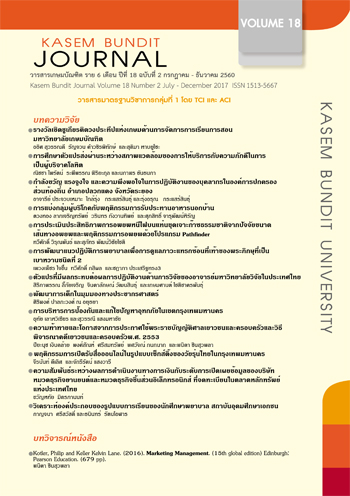พัฒนาการเด็กในมุมมองทางประชากรศาสตร์
Keywords:
พัฒนาการเด็ก, ประชากรศาสตร์, การเปลี่ยนแปลงโครงสร้างทางอายุประชากร, คุณภาพชีวิตประชากร, Child development, Demography, Changing of population-age structure, Quality of population’s lifeAbstract
บทความนี้มุ่งนำเสนอทัศนะและองค์ความรู้เกี่ยวกับ “พัฒนาการเด็ก” ในทางประชากรศาสตร์เพื่อชี้ให้เห็นว่า ประเด็นเรื่องพัฒนาการเด็กสามารถได้รับการพิจารณาว่าเป็นมิติหนึ่งของคุณภาพชีวิตประชากรที่ควรให้ความสำคัญอันเนื่องมาจากสถานการณ์การเปลี่ยนแปลงโครงสร้างทางอายุประชากรที่เกิดขึ้น จากการวิจัยเอกสารที่เกี่ยวข้องกับพัฒนาการเด็กในงานศึกษาทางประชากรศาสตร์ และการเชื่อมโยงประเด็นพัฒนาการเด็กจากทัศนะของสาขาวิชาอื่น ๆ ที่เกี่ยวข้องทางเศรษฐศาสตร์และทางสังคมวิทยา นอกจากนี้ได้นำเสนอการวิเคราะห์แนวโน้มการศึกษาเรื่องพัฒนาการเด็กในทางประชากรศาสตร์ต่อไปในอนาคต
This article aimed to present perspectives and knowledge about child development in the field of demography. It regarded the study of child development as a crucial issue affecting quality of population’s life because of changing population-age structure. The article was based primarily on documentary research with an attempt to link the child development with the other fields’ perspectives related to demography, i. e, economics and sociological aspects. In addition, the article presents future trends of study on child development.
References
Baumrind, D. (1971). Current patterns of parental authority. Developmental Psychology, 4, 1: 1-103.
Becker, G. S. (1960). An Economic Analysis of Fertility Demographic and Economic Change in Developed Countries. Columbia University Press.
Bourgeois – Pichat, Jean. (1946). ‘De la mesure de la mortalité infantile’. Population, 1, 53-68.
Caldwell, J. C. (1982). Theory of Fertility Decline. New York: Academic Press.
Chanaim, Sucha. (2540). Developmental Psychology. (4th edition). Bangkok: Thai Watana Panich Press.
Cummings, E. M. and Schatz, J. N. (2012). Family conflict, emotional security, and child development: translating research findings into a prevention program for community families. Clinical Child and Family Psychology Review, 15, 1: 14-27.
Dacey, John S. (2009). Human Development across the Lifespan. (7th edition). New York: McGraw-Hill.
Dunn, J. (1988). Sibling influences on childhood development. Journal of Child Psychology and Psychiatry, 29, 2: 119-127.
Easterlin, R. A. (1975). An economic framework for fertility analysis. Studies in Family Planning, 6(3), 54-63.
Eric, A. H. and Ludger, W. (2012). Do better schools lead to more growth? Cognitive skills, economic outcomes, and causation. Journal of Economic Growth, 17, 4: 267-321.
Ezeonwu, B. U., Chima, O. U., Oguonu, T., Ikefuna, A. N. and Nwafor I. (2014). Morbidity and mortality pattern of childhood illnesses seen at the children emergency unit of federal medical center, Asaba, Nigeria . Annals of Medical & Health Science Research, 4, 3: 239-244.
Grover, V. L., Chhabra, P., Malik, S., and Kannan, A. T. (2004). Pattern of morbidity and mortality amongst under fives in an urban resettlement colony of East Delhi. Indian Journal of Preventive and Social Medicine, 35(1-2), 22-26.
Heckman, James J. and Masterov, Dimitriy V. (2007). The productivity argument for investing in young children. Review of Agricultural Economics, 29, 3: 446-493.
Heckman, James J. (2008). Schools, skills, and synapses. Economic Inquiry, 46, 3: 289-324.
Heckman, James J. (2012). Invest in early childhood development: reduce deficits, strengthen the economy. Available from: file:///C:/Users/win7 /Downloads /F_HeckmanDeficitPieceCUSTOM-Generic_052714.pdf, accessed 4 April 2015.
Heckman, James J. and Mosso, Stefano. (2014). The economics of human development and social mobility. Annual Review of Economics, 61, 1: 689-733.
Hernandez, Donald J. (1997). Child development and the social demography of childhood,Child Development, 68, 1: 149-169.
Hernandez, Donald J. (2012). Changing Demography and Circumstances for Young Black Children in African and Caribbean Immigrant Families. Washington, DC: Migration Policy Institute.
Howe, C. 2010. Peer Groups and Children's Development. Oxford: Blackwell.
Hunchangsith, Boonkong. (2543). Economics of Human Resource: Population, Labor, Education, Training, Religious Teaching, Ethics, Health, and Environment. (2nd. edition). Bangkok: O. S. Printing House.
Kirk, D. (1996). Demographic transition theory. Population Studies, 50(3), 361-387.
Lutz, Wolfgang and K.C., Samir Kumar. (2013). Demography and human development: education and population projections. Available from: http://ssrn.com/ abstract=2344470, accessed 11 April 2015.
Masuy-Stroobant, G. (2006). Theories and frameworks for the study of child mortality. In Caselli, G.; Wunsch, G.; Vallin, J. (editors). Demography: Analysis and Synthesis, Four Volume Set: A Treatise in Population. Burlington, MA: Academic Press, Volume 2, 237–246.
Mercer, N., and Howe, C. (2012). Explaining the dialogic processes of teaching and learning: the value and potential of sociocultural theory. Learning, Culture, and Social Interaction, 1, 1: 12-21.
Minuchin, P. (2002). Looking toward the horizon: present and future in the study of family systems, In J. McHale and W. Grolnick (editors). Retrospect and Prospect in the Psychological Study of Families. London: Lawrence Erlbaum Associates.
National Research Council (US) and Institute of Medicine (US). (2004). Children’s Health, The Nation’s Wealth: Assessing and Improving Child Health. Washington, DC: National Academies Press.
National Scientific Council on the Developing Child. (2009). Young children develop in an environment of relationships. Available from Internet, http://www.developingchild.net , accessed 4 April 2015.
Pholpirul, Piriya, and Rkumnuaykit, Pungpond. (2558). Human Capital and Productivity of Labor in Thailand Industry Sectors. Bangkok: The Thailand Research Fund.
Poochareon, Worapat. (2543). Student-centered Learning Administration. Bangkok: Technology Promotion Association (Thailand-Japan).
Prasartkul, Pramote. (2543). Demography: Educational Foundation of Population. Bangkok: Amarin Printing and Publishing.
Prasartkul, Pramote and Vapattanawong, Patama. (2555). Population structure and change, Thai Health Report 2012. Nonthaburi: Health Information System Development Office.
Pryor, Jan. and Rodgers, Bryan. (2001). Children in Changing Families: Life after Parental Separation. Oxford: Blackwell Publishers.
Reher, D. S. and González-Quiñones F. D. (2003). Parents really matter? Child health and development in Spain during the demographic transition. Population Studies: A Journal of Demography, 57, 1: 63-75.
Siriwanbut, Panthip et al. (2545). Study of Pattern of Relationships between Contemporary Behaviors of Thai People and Socialization Process of Thai Families in Relation to the Development of the Country. Bangkok: Chulalongkorn University.
Supap, Supatra. (2546). Sociology. (23rd edition). Bangkok: Thai Watana Panich Press.
Usanova, E. P., Matveeva, N. A., Leonov, A. V. and Shulyndina, L. V. (1984). Effect of exogenous and endogenous factors on somatic and mental development of children. Gigiena Sanitariia, 12 (Dec): 16-17.
Vorasiriamorn, Yupin et al. (editors). (2557). Population and Society 2014: Birth and Security in Population and Society. Nakorn Pathom: Institution for Population and Social Research, Mahidol University.
Wilson, B. J., & Gottman, J. M. (2002). Marital conflict, repair, and parenting. Handbook of Parenting, 4, 227-258.
Downloads
Published
How to Cite
Issue
Section
License
ทัศนคติ ความคิดเห็นใด ๆ ที่ปรากฏในวารสารเกษมบัณฑิตฉบับนี้เป็นของผู้เขียน โดยเฉพาะ มหาวิทยาลัยเกษมบัณฑิตและบรรณาธิการ ไม่จำเป็นต้องมีความเห็นพ้องด้วย







